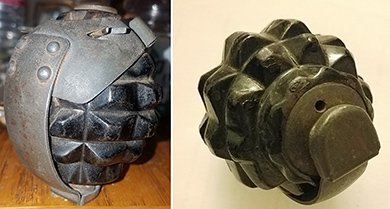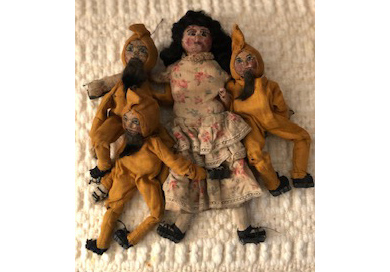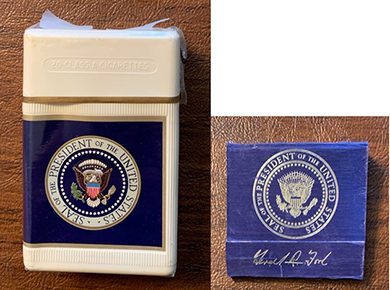 |
|
|||
 |
 |
|||
RINKER ON COLLECTIBLES — Column #1789 Copyright © Harry Rinker, LLC 2021 Questions
and Answers
QUESTION: I have what I believe to possibly be a World War I United States military hand grenade. It has been deactivated so it is totally safe. What can you tell me about its history and can you provide me with a ballpark estimate of its value? – MB, Bakersfield, CA, E-mail Question 
ANSWER: Thank you for the detailed photographs that accompanied your email. They were a tremendous help in finally identifying your grenade. I forwarded your email to my son Harry, Jr., who is a military collector and occasional dealer, re-enactor, gunsmith, and firearms’ restorer. His initial thought was that the grenade was a Mills bomb hand grenade, developed by Captain Leon Roland of the Belgian Army, and used extensively by the British military from World War I into World War II. When I saw pictures of the Mills bomb hand grenade and compared it with your photos, the match was extremely close. Close is no cigar in the antiques and collectibles field. Harry Jr. urged me to wait while he posted the pictures on several collector sites on the internet to see if anyone could positively identify the grenade type. Patience proved to be a virtue. Harry Jr. heard back from a collector who identified your grenade as a Shinkle Grenade developed by Major Edward Marsh Shinkle of the United States Army who was stationed at the Frankford Arsenal in Philadelphia. This grenade preceded the pineapple-shaped MK1 (Mills bomb) grenade. The Shinkle grenade had an impact fuse. The first test of the concussion type Shinkle grenade occurred in 1918. Unfortunately, impact fuses proved unreliable in the damp and muddy trench environment of World War I. AEF (American Expositionary Force) commanders in Europe made it clear they did not want an impact grenade. The US Army suspended production of the Shinkle grenade. Meanwhile, production of the MKI grenade with its delayed fuse increased. Never surrender is a military strategy. Hence, the US Army eventually returned to the Shinkle grenade and made approximately 800 before World War I ended. On June 13, 2019, Morphy Auctions in Denver, Pennsylvania, sold a Shinkle grenade for $2,767.50, a price that included the buyer’s penalty. The estimate was $1,100.00 to $1,300.00. The description of the grenade was: “This grenade is in excellent condition and is complete with spoon and safety pin. The only ‘damage’ is a miniscule proof of inert hole located through the center of the screwdriver slot of the filling plug.” The difficulty of a “price realized” number from an auction company is that it contains the buyer’s penalty (payable to the auction company and not the consignor) and does not reflect the commission and other fees charged by the auction company to sell the object. In talking with other collectors, Harry Jr. recommended a retail price of between $1,500.00 and $1,700.00 for your grenade based on his analysis of the photographs. The other difficulty is completeness. There were more than a dozen internal pieces such as a plunger and spring inside the grenade. They often were removed and discarded when grenades were defused. An example missing the internal parts is worth less than an example in which the internal parts still are present. In summary, you own a very desirable World War I military collectible. QUESTION: I purchased a collection of “weird” dolls from a secondhand store. They were so weird, I just had to have them. The doll came with three elf-like dolls. I could not find any information about the dolls in doll reference books or on the internet. I am very curious as to their origin, age, and value. Any information you can provide is welcome. – CF, Sacramento, CA, E-mail Question 
ANSWER: I also was unable to find an identical doll or elf-like doll on the internet. I found several close examples such as the Todd Hunter Wee Folk Series and German Googly Eye (Palmer Cox Brownies) but no exact match. I forwarded your email to Dawn Herlocker, a good friend and author of several books on doll identification and values. She responded: “Looks like Depression dolls. During the Depression era, a person could purchase a doll face, hands, and other parts so the person could make their own dolls. The crude body of the doll strongly suggests a Depression era origin. The doll and elves are interesting. It would be fun to know their story…” I felt the same way. I often am frustrated by the minimal information that accompanies so many of the email questions I receive. I emailed CF and asked in what type of shop she bought the dolls, what she was told when she bought them, how tall were the doll and pixie/elf dolls, and what did she pay, a relevant piece of information when considering value. CF responded: “I purchased these dolls at a Sacramento, California, S.P.C.A. store in 2013. I paid $7.00 each. The store clerk believed they were part of a set of Snow White and the Seven Dwarfs. The female doll is 8-inches tall and elves/dwarves are 6-inches tall. The hands and feet of the doll and dwarfs have pieces of stone sewn onto them. It is clear the bodies are hand stitched. The beards on the elves/dwarfs appear to be made from the hide of a small animal.” Bingo! Disney released its movie cartoon “Snow White and the Seven Dwarfs” in 1937. Clearly, a mother did not have the funds to buy her child one of the Disney licensed, commercial Snow White sets. Not wishing to disappoint her child, the mother made her own Snow White and the Seven Dwarfs set. Dawn noted in her email: “I know it is always uncomfortable to tell someone that their treasured find has little value, but in this case it is true. If CF loved them enough to buy them that is all that should matter. The fact that a mother with no money, living during the Depression wanted so badly for her child to have a doll set that she gathered material and worked at her kitchen table, possibly by the light of an oil lamp, late at night to surprise the child in the morning makes the doll and the elves/dwarfs priceless in a non-monetary sense.” Dawn and I think alike. CF spent $28.00 for the doll set. I probably would have as well. The doll set is not weird. It is neat. Will someone pay $50.00 for the same objects and story? Possibly, but who cares? They are worth every penny CF paid and more. QUESTION: I have a President Gerald Ford cigarette pack and matchbook in very good condition. What is it worth? Should I consider donating it to the President Ford Archives? – CF, Email Question 
ANSWER: Presidential cigarette packs and matchbooks appear regularly for sale on the internet. I suspect that most individuals who acquired them never used them but saved them as souvenirs. I did a quick WorthPoint.com “sale date” search. I was not surprised to find the range of prices varied considerably. Two (2) individual packs sold on July 12, 2020, on eBay for $12.95. At the same time, an individual pack sold on May 17, 2020, for $49.99. The is ample proof that value depends on a wide variety of variables such as who is bidding at a specific time and place. A pack of cigarettes and a “white” (your cover is blue) matchbook sold for $65.00 on March 12, 2020. A pack of cigarettes and two matchbooks brought $13.95 on eBay on April 23, 2018. If you are planning to sell the cigarettes and matchbook, take any offer over $20.00. You can offer to donate the cigarette pack and matchbook to the Presidential Ford Museum in Grand Rapids. I serve as a volunteer there. Do not be surprised if the museum declines. Several years ago, I offered to donate several pieces of Ford memorabilia to the museum from my collection. The museum only kept one campaign tie (of course, the one I did not want to give up) and rejected and returned the rest because they already had examples in the collection. The Ford Presidential Library and Museum is the only presidential collection that is split into two parts. The archives (paper documents) and library are housed at the University of Michigan in Ann Arbor. The physical objects are collected and displayed at the Ford Museum in Grand Rapids. Your cigarette pack and matchbook are considered to be “physical” objects.
Harry L. Rinker welcomes questions from readers about
collectibles, those mass-produced items from the twentieth and twenty-first centuries.
Selected letters will be answered in this column.
Harry cannot provide personal answers.
Photos and other material submitted cannot be
returned.
Send your questions to: Rinker on Collectibles, 5955 Mill
Point Court SE, Kentwood, MI 49512.
You also can e-mail your questions to
harrylrinker@aol.com.
Only e-mails containing a full name and mailing address
will be considered.
|
||||